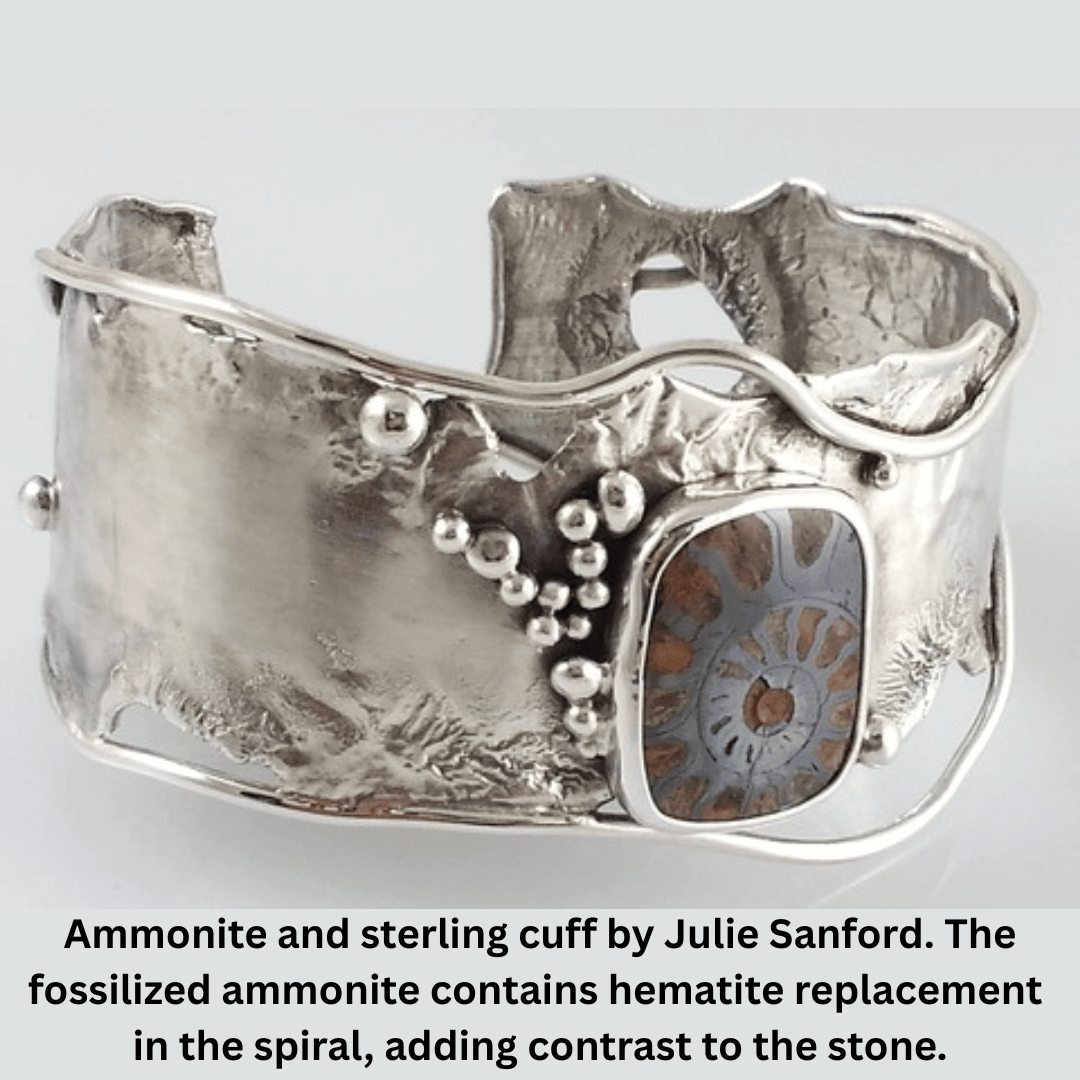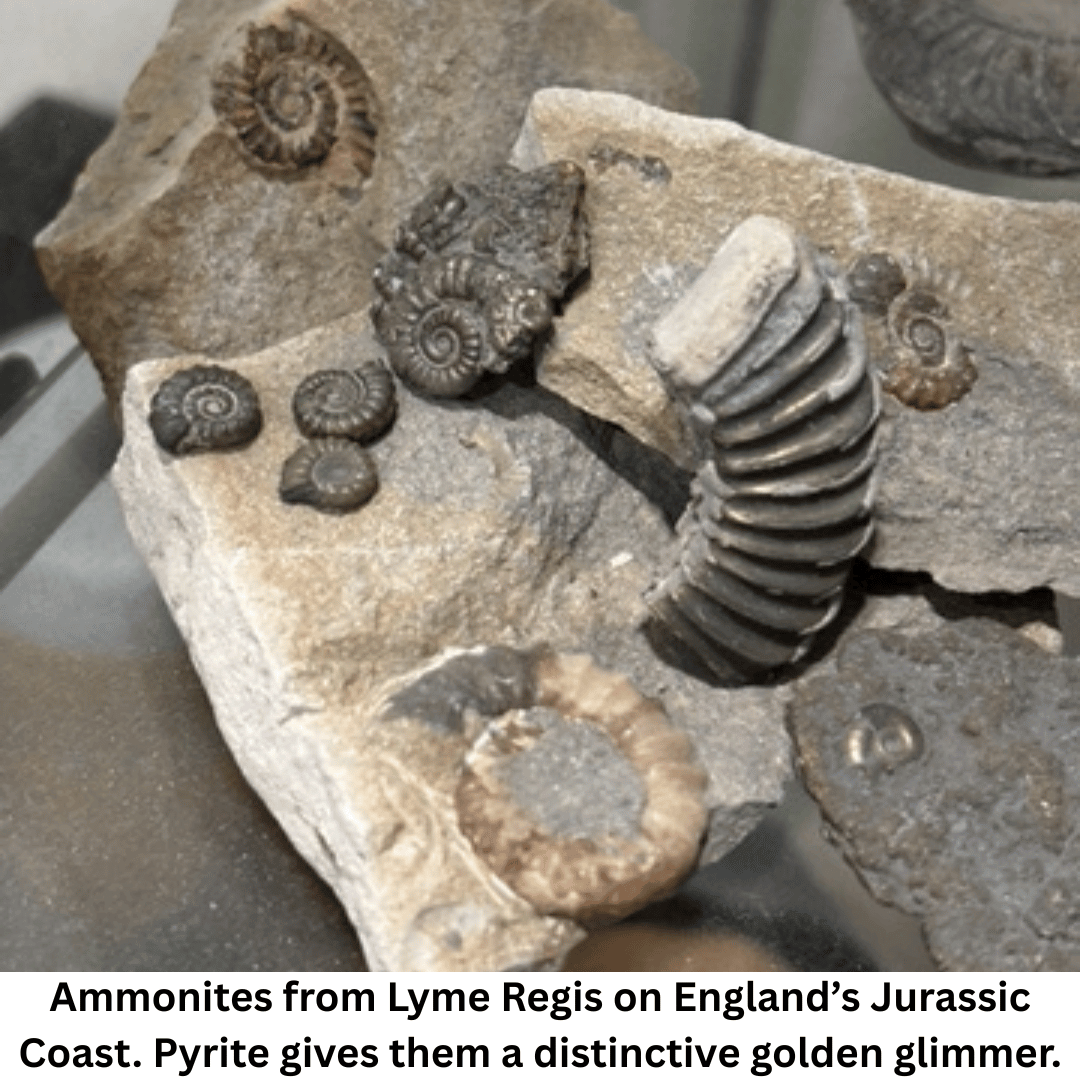If you’ve ever marveled over a fossil displayed in a gem show or embedded in a creek bank, you’ve already experienced the thrill of connecting with the past. This spark of curiosity draws many people to collecting fossils – an intriguing hobby for rockhounds of all ages and skill levels. As Jewelry artist Julie Sanford says, “Fossils are so mysterious, a snapshot of a distant time.” Crinoids, coral, petrified wood, plant imprints, and other fossils make beautiful conversation pieces, home décor, and jewelry. Part science, part treasure hunt, fossil collecting combines curiosity, adventure, and the fascination of connecting to ancient life. To get started collecting fossils, follow these tips.
Start Small
Many fossil collectors begin with ammonites, trilobites, or shark teeth. These finds are relatively common to find and typically inexpensive to purchase. As with any collection, it pays to do some research before you buy your first fossil. However, if you find yourself captivated by a specific fossil and you’re ready to buy it, ask yourself these key questions: Is it in my budget? How will I use it? Do I have a place for it? For instance, will it become a decorative item in your home, an element in a jewelry design, or do you simply want to own it now and you’ll figure it out later? Starting small allows your collection to expand as your knowledge and inspiration grow.
Document Your Collection
When shopping for fossils, bring a permanent marker and a variety of plastic baggies to keep track of what you purchase, where it came from, and how much you paid. Taking a few minutes to jot down additional details about each fossil can save you time later and make your collection more meaningful. Ask yourself questions like: Is there a story behind why you chose this particular specimen? How do you plan to use it—display, jewelry, or another use? For example, Julie Sanford notes that the squid-like appearance of an ammonite she purchased inspired the design of her ammonite cuff.
Consider creating a dedicated fossil log, either in a notebook or digitally using a spreadsheet or app. Include fields for the fossil’s name, location, date purchased or found, price, and any notes about inspiration or plans for use. Adding a photograph of the specimen can also be helpful, especially for smaller items or ones you plan to incorporate into jewelry or crafts. Over time, this record becomes a personal reference and a way to track the growth and evolution of your collection. By recording these details as you shop, you preserve practical information and the creative inspiration behind your finds, ensuring that each fossil’s story is safeguarded for the future.
Seek Information
Fossil vendors often enjoy sharing information about their specimens, so don’t hesitate to ask questions about your potential acquisitions. Learning about a fossil's species, age, and where it was discovered will add depth and, in some cases, value to your collection. You may also wonder how the fossil was prepared or preserved, as different techniques can impact its appearance and durability. Many fossils also have symbolic meanings–shark’s teeth represent strength, ammonites are associated with transformation, and trilobites are often associated with resilience–which can make your collection more personally meaningful. In addition, vendors can sometimes provide tips on care, display, or even ideas for incorporating fossils into jewelry or home décor. Engaging with knowledgeable sellers helps you make informed choices and enriches your experience as a collector.
Ensuring Authenticity

Inexperienced shoppers are frequently concerned about buying inauthentic fossils. Common fakes include dyed teeth, resin-casted trilobites, and limestone ammonite carvings. The best insurance against unknowingly buying reproductions or enhanced fossils is to find vendors you can rely on and train your own eye to recognize signs of authenticity. Prioritize shopping with sellers who can guarantee that their fossils were sourced legally and responsibly. Channel your inner detective and bring a magnifying loupe so you can closely examine your fossil. It can be very helpful to compare the specimen against a reference image in a guide or on your phone. If you have any doubts, consult an experienced collector before making a purchase.
Fossil Hunting in the Wild
Jewelry artist Melissa Cable finds family entertainment and jewelry design inspiration while collecting fossils. She says, “Fossil hunting is the ultimate family vacation trifecta: quality time together, outdoor adventure, and hands-on learning. There’s nothing more thrilling than digging in the dirt or splitting open a rock and discovering treasure inside.” Melissa’s advice for fossil hunting with kids (or any beginners) is to keep it easy and fun by limiting your time and choosing spots where success is almost guaranteed. Fossil collecting encourages patience and curiosity in children and adults alike. When you’re hunting in a new area, you’ll benefit from hiring a guide or joining a club on their outing.
Bring a Book or Use an App
Before heading out to your nearest fossil bed on your own, use a guidebook or an app to help identify what you’ll be looking for. These visual aids can help avoid feelings of overwhelm and keep things fun for beginners. You’ll need permission to hunt on private property, and some public lands require permits, with a limit on the number and type of fossils you can collect, so research local regulations. For example, gathering vertebrate fossils is typically prohibited on public land. Rockhounding and fossil clubs often set the tone for collecting fossils, with reminders to leave nature as you found it, reduce your impact as much as possible, and leave fossils for others to find.
Stay Safe Out There
As with any nature expedition, safety is essential when fossil hunting. Beware of weather considerations, such as flash floods, when searching in creekbeds. Wear protective gear, such as safety glasses, a hat, sunscreen, gloves, long sleeves, long pants, and closed-toe shoes, to protect against sharp rocks and sun exposure. Remember the basics of any outdoor adventure and bring plenty of drinking water, a first aid kit, and a tote for carrying your treasures. It’s best to take your time—fossils have waited millions of years to be unearthed, so you don’t need to hurry.
Make and Record Special Memories
Keeping a log of your discoveries is just as important when you find fossils as when you purchase them. Take a photo and write down the story behind finding the fossil, along with any ideas you have for displaying it. Melissa Cable describes her most treasured find, “My favorite specimens are a pair of dime-sized full ammonites that glisten gold from pyrite. I still plan to turn them into earrings someday.” This information adds an extra element of significance to your collection.
Finding fossils frequently provides rewards beyond the fossils themselves. When Melissa’s family went fossil hunting in the Green River Formation in Wyoming, they were treated to a surprise that has become a treasured part of their family lore: full fish fossils. She says, “After an hour of splitting limestone sheets into pieces filled with partial fossils, the mine owner surprised our kids with a perfectly matched set of complete fish fossils he had found himself, a kind gift that made their day!” Melissa has plans to have these special gifts professionally mounted so the kids can display them in their future homes.
Find Your Nearest Fossils
Chances are, there is good fossil hunting in your area. In the eastern United States, the Potomac River area is known for fossilized shark teeth. There are several official sites to visit that offer Paleocene fossil collecting. Or, follow the Ohio River Valley Fossil Trail, which is a collaboration between parks, museums, and other sites where Ordovician fossils can be seen, touched, and sometimes hunted in Ohio, Indiana, and Kentucky. Head south to Texas, where the limestone beds around Austin and Waco yield plentiful marine fossils such as echinoids and ammonites.
While the western states are famous for dinosaur bones from the Jurassic and Cretaceous periods, there are also many sites where you can collect fossils from other eras. The Ernst Quarries located near Sharktooth Hill, California, are home to the largest deposit of Miocene marine fossils in the world. In the Pacific Northwest, Washington’s beaches are known to reveal fossilized clams and plants.
If you want to go farther afield in your fossil-hunting adventures, Lyme Regis, on England’s Jurassic Coast, contains ammonites of every size right on the beach and is the birthplace of the famous fossil hunter and trailblazing paleontologist Mary Anning. You can search for trilobites, ammonites, and other fossils in Morocco, and Germany is well-known for marine fossils.
You’ll find many more fossil-collecting site recommendations on Reddit's r/FossilHunting forum and helpful state-by-state listings on FossilSites.com. Whether you stay close to home or travel to a fossil collecting site, enjoy your journey into the past. Wherever you look for fossils, you’re discovering a link to life as it existed millions of years ago.
Start Your Adventure
Whether you’re shopping at your nearest gem show or heading outdoors to collect fossils, you belong to a long line of folks who are fascinated by this link to the ancient past. As you pursue your interest and your collection grows, consider joining in-person and online fossil clubs where you can learn and connect with other people who are passionate about fossils, too. This intriguing hobby brings together rockhounds of any age or skill level–and there’s no time like the present to learn about the past.
Katie Hacker is a jewelry designer, author, and lifelong maker who is passionate about the beauty of stones and gems. A former editor of the Tucson Show Guide and host of PBS’s Beads, Baubles & Jewels, she’s passionate about inspiring makers of all levels. Katie enjoys treasure hunting at gem shows and writing articles filled with insider tips and creative ideas to help readers discover their own spark. Katie found her love of fossil hunting as a child, searching creek beds for hidden treasures. You can find Katie on Instagram @katiehackerstudio.
—------------------
Photo Credits:
Ammonite and sterling cuff by Julie Sanford. The fossilized ammonite contains hematite replacement in the spiral, adding contrast to the stone. Photo credit: Julie Sanford Designs, www.juliesanforddesigns.com
Complete fish fossil from the Green River Formation in Wyoming. This generous gift kept two children going after a long day of hunting fossils. Photo credit: Melissa Cable, www.heirloominary.com.
Ammonites from Lyme Regis on England’s Jurassic Coast. Pyrite gives them a distinctive golden glimmer. Photo credit: Melissa Cable, www.heirloominary.com.




